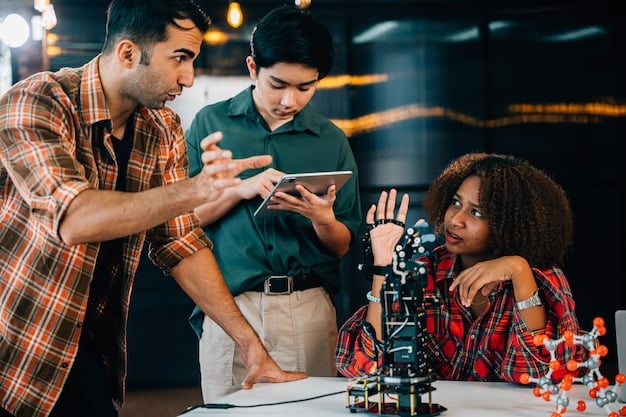US Universities & Automation: Future of Work Prep

Many US universities are actively reshaping curricula and pedagogical approaches to equip students with the necessary skills and adaptability to thrive in a workforce increasingly impacted by automation, focusing on interdisciplinary studies, critical thinking, and digital literacy.
As the landscape of employment continues to evolve rapidly, one question increasingly looms large for educators and policymakers alike: How are US universities preparing students for the future of work in the age of automation? This is not merely an academic exercise, but a critical interrogation of how higher education institutions are adapting to ensure graduates possess the skills and resilience vital for success in an economy fundamentally reshaped by artificial intelligence, robotics, and advanced computational power.
Redefining Curricula for the Automated Era
The traditional pillars of higher education are undergoing significant re-evaluation as universities confront the pervasive influence of automation. This redefinition extends beyond merely adding new courses; it involves a holistic reconsideration of what constitutes relevant knowledge and skill in a world where routine tasks are increasingly delegated to machines. Universities are recognizing that a narrow specialization might not be sufficient and that a broader, more adaptable educational foundation is essential.
One primary shift is the integration of digital literacy and computational thinking across a wider array of disciplines. No longer confined to computer science departments, these skills are being woven into humanities, arts, and social sciences programs. The goal is to cultivate a generation of graduates who can not only use technology but understand its underlying principles and implications, fostering a more nuanced interaction with automated systems.
Embracing interdisciplinary studies
Forward-thinking universities are dismantling traditional academic silos to foster truly interdisciplinary programs. This approach acknowledges that complex challenges in an automated world rarely fit neatly into a single academic box. By encouraging students to draw connections between seemingly disparate fields, institutions are cultivating problem-solvers equipped to tackle multifaceted issues.
- Data Science for All: Many universities are introducing introductory data science courses not just for STEM majors, but for students across all disciplines, recognizing data as the new lingua franca of the automated age.
- Ethical AI Integration: Courses on the ethical implications of artificial intelligence are becoming common, often developed collaboratively by philosophy, computer science, and law departments.
- Human-Machine Interaction Design: Programs are emerging that blend aspects of psychology, design, and engineering to prepare students for roles involving the seamless integration of humans with advanced technological systems.
Furthermore, the focus is shifting from rote memorization to analytical reasoning and critical evaluation. In a world where information is instantly accessible, the ability to discern, synthesize, and apply knowledge becomes paramount. Universities are designing assignments and projects that demand higher-order thinking skills, preparing students not just for current jobs, but for roles that have yet to be conceived.
Fostering Adaptability and Lifelong Learning
Recognizing that the pace of technological change shows no signs of slowing, US universities are placing a strong emphasis on cultivating adaptability and promoting a mindset of lifelong learning. The notion of a static career path, where skills learned in college suffice for an entire professional life, is rapidly becoming obsolete. Instead, institutions are acknowledging that graduates will need to continuously acquire new competencies to remain relevant.
This includes embedding modules on agile methodologies and growth mindsets within various curricula, preparing students to embrace change rather than resist it. The emphasis is on developing meta-skills—the ability to learn, unlearn, and relearn—which are arguably more critical than any specific technical skill given the dynamic nature of the future workforce. Universities are becoming facilitators of continuous intellectual development, rather than terminal points of education.
Developing soft skills for hard problems
While technical prowess is undeniably important in an automated landscape, universities are increasingly aware that human-centric skills will be the true differentiators. Automation excels at routine and analytical tasks, but it largely struggles with complex interpersonal interactions, creativity, and nuanced problem-solving. Therefore, the ability to communicate effectively, collaborate, and think critically are becoming invaluable.
- Enhanced Communication Training: Many programs are integrating advanced communication workshops, focusing on presenting complex technical information clearly to non-technical audiences.
- Project-Based Learning: Collaborative, project-based assignments are becoming standard, forcing students to work in teams, negotiate, and resolve conflicts—mirroring real-world professional environments.
- Creative Problem Solving: Courses designed to stimulate divergent thinking and innovative solutions are being introduced, often incorporating design thinking methodologies to tackle open-ended challenges.

Moreover, universities are building stronger bridges between academia and industry. Internships, co-op programs, and industry-sponsored projects are becoming integral components of many degree programs, providing students with direct exposure to real-world challenges and the evolving demands of the job market. This practical experience not only hones specific skills but also instills the flexibility and professional acumen necessary to navigate dynamic work environments.
Integrating AI and Robotics into Learning Experiences
Beyond simply teaching about automation, US universities are actively integrating artificial intelligence and robotics into the very fabric of the learning experience itself. This hands-on approach allows students to interact directly with the technologies that are reshaping industries, moving beyond theoretical understanding to practical application and even development. The aim is to demystify these advanced systems and empower students to become creators and innovators, not just consumers.
Lab facilities are being upgraded with state-of-the-art robotic arms, AI development platforms, and virtual reality environments, providing students with safe spaces to experiment and fail forward. This immersive learning environment mimics the cutting-edge workspaces they will encounter in their careers, offering an invaluable head start. The focus is on active learning, where students are encouraged to build, program, and troubleshoot, developing a deep, intuitive understanding of these complex systems.
Experiential learning and capstone projects
Many programs now culminate in capstone projects where students apply their knowledge to solve real-world problems using AI and robotics. These projects often involve collaborations with industry partners, providing students with practical experience and networking opportunities. Such experiences move beyond theoretical concepts, challenging students to integrate various skill sets and deliver tangible outcomes.
- Robotics Competitions: University teams are actively participating in national and international robotics competitions, which drive innovation and collaborative problem-solving.
- AI-Powered Research Labs: Students are increasingly involved in research labs that utilize AI for data analysis, simulation, and even drug discovery, contributing to genuine scientific advancements.
- Virtual Reality Simulations: Medical and engineering schools are using VR and AR to simulate complex procedures and environments, allowing students to practice critical skills without real-world risks.
Furthermore, institutions are exploring how AI tools can enhance the learning process itself. This includes AI-powered tutoring systems, personalized learning paths, and intelligent feedback mechanisms that can adapt to individual student needs. While still in nascent stages, the potential for AI to revolutionize pedagogy is a significant area of current university exploration, aiming to make education more efficient and effective.
Addressing the Skills Gap: Partnerships and Pathways
Recognizing that higher education cannot operate in isolation, US universities are forging stronger partnerships with industry, government, and community organizations to address the emerging skills gap. This collaborative approach ensures that curricula remain relevant to the evolving demands of the job market and that students are prepared for specific, high-demand roles in the automated economy. These partnerships often involve shared resources, joint research initiatives, and mutual feedback loops.
Many universities are engaging corporate leaders and recruiters in curriculum advisory boards, ensuring that course content aligns with industry needs. This direct line of communication helps institutions quickly adapt to technological shifts and ensure that graduates possess competencies employers actively seek. This symbiotic relationship ensures that academic rigor meets practical applicability.
Micro-credentials and continuous education
The traditional four-year degree is being complemented by new, more flexible educational pathways designed for rapid upskilling and reskilling. Micro-credentials, bootcamps, and specialized certificate programs are becoming vital components of university offerings, catering to both current students and working professionals needing to adapt to automation.
- Stackable Credentials: Universities are designing short, focused courses that can be “stacked” together to form larger qualifications, allowing individuals to build expertise modularly.
- Corporate Training Programs: Many institutions are collaborating directly with companies to offer customized training programs that address specific technological gaps within their workforces.
- Online and Hybrid Learning: The expansion of online and hybrid learning formats has made continuous education more accessible, allowing individuals to learn at their own pace and convenience while balancing work commitments.

These initiatives not only provide essential skills but also broaden access to education for a more diverse population, including those already in the workforce who need to pivot their careers. By offering these flexible learning options, universities are positioning themselves not just as initial educators, but as lifelong partners in professional development, pivotal for navigating an economy that demands constant adaptation.
Cultivating Entrepreneurship and Innovation
In an age where automation is disrupting established industries and creating new ones, US universities are increasingly focusing on cultivating an entrepreneurial mindset among their students. Beyond preparing them for existing jobs, institutions are empowering students to become creators of future jobs, to innovate, and to launch their own ventures that leverage or address the implications of automation. This shift is about fostering proactive engagement with change.
This includes establishing incubators, accelerators, and venture funds within university ecosystems. These resources provide students with mentorship, funding, and practical support to transform their innovative ideas into viable businesses. Universities are moving beyond theoretical business studies to offer a hands-on, practical approach to startup development, mirroring the dynamic world of technological innovation.
Design thinking and lean startup methodologies
Many programs are integrating methodologies like design thinking and lean startup principles, which emphasize iterative development, rapid prototyping, and customer feedback. These approaches are particularly relevant in rapidly evolving technological fields, allowing aspiring entrepreneurs to test ideas quickly and adapt based on market responses.
- Startup Competitions: Universities host regular pitch competitions and hackathons, encouraging students to develop and present innovative solutions to real-world problems.
- Entrepreneurship Centers: Dedicated centers provide resources such as mentorship networks, legal advice, and access to funding, significantly lowering the barrier to entry for student entrepreneurs.
- Interdisciplinary Teams: Encouragement of interdisciplinary teams for entrepreneurial projects ensures that ventures benefit from a broad range of perspectives and skills, from technical expertise to business acumen.
Moreover, the emphasis is placed on identifying problems that automation can solve or opportunities it creates. Students are encouraged to think critically about market needs and to develop solutions that are not only technologically sound but also commercially viable and socially impactful. This entrepreneurial spirit is seen as a key attribute for navigating the unpredictable future of work, turning challenges into opportunities.
Ethical Considerations and Societal Impact
As US universities prepare students for a future shaped by automation, there is a growing recognition of the profound ethical and societal implications of these technologies. It is not enough to simply train students in technical skills; they must also be equipped to grapple with the deeper questions surrounding job displacement, algorithmic bias, privacy, and the equitable distribution of automation’s benefits. This goes beyond the realm of pure technology into the crucial domain of responsible innovation.
Courses on technology ethics, digital responsibility, and the social impact of AI are becoming integral parts of various curricula, often developed in collaboration between humanities, social sciences, and engineering departments. The aim is to cultivate a nuanced understanding of how technological advancements intersect with human values and societal well-being. This ensures that graduates are not just technically proficient but also socially conscious innovators.
Addressing ethical dilemmas in practice
Case studies and simulations based on real-world ethical dilemmas in AI and automation are increasingly used in classrooms. This allows students to critically analyze complex situations, debate potential solutions, and understand the far-reaching consequences of technological decisions on individuals and communities.
- Bias in Algorithms: Students are taught to identify and mitigate algorithmic biases, recognizing how unchecked AI can perpetuate or amplify existing societal inequalities.
- Privacy and Data Governance: Programs emphasize the importance of data privacy, secure data handling, and ethical data governance practices in the design and deployment of automated systems.
- Future of Work Justice: Discussions around the broader economic and social justice implications of widespread automation, including policy responses to job displacement and income inequality, are becoming more common.
By embedding these ethical considerations throughout the curriculum, universities are aiming to produce a generation of leaders and innovators who are not only technically competent but also deeply committed to using automation responsibly for the betterment of society. This holistic approach ensures that technological progress is guided by a strong moral compass, addressing both the opportunities and potential pitfalls of an automated future.
| Key Initiatives | Brief Description |
|---|---|
| 📚 Curricular Redefinition | Integrating digital literacy, computational thinking, and interdisciplinary studies across diverse fields. |
| 🌱 Adaptability & Lifelong Learning | Fostering meta-skills, soft skills, and promoting continuous education through flexible pathways. |
| 🤖 Hands-on AI/Robotics | Implementing experiential learning, capstone projects, and advanced lab facilities for direct interaction with tech. |
| 🤝 Industry Partnerships | Collaborating with industry for curriculum relevance, internships, micro-credentials, and professional development. |
Frequently asked questions about universities and the future of work
▼
The greatest challenge is the rapid pace of technological change itself. Curricula can quickly become outdated. Universities must implement agile systems for continuous curriculum review and adaptation, ensuring that educational content evolves as fast as the industry demands, rather than lagging behind.
▼
Absolutely. Humanities and arts degrees are more relevant than ever. They foster critical thinking, creativity, ethical reasoning, and nuanced communication—skills that complement automation and are difficult for machines to replicate. These disciplines equip students to understand the broader societal impact and purpose of technology.
▼
Universities are integrating ethics into technology curricula, offering dedicated courses on AI ethics, and encouraging interdisciplinary discussions. They are also developing research initiatives focused on responsible AI development and policy, aiming to produce graduates who are not only technically proficient but also ethically conscious designers and users of automation.
▼
Internships and co-op programs are crucial. They provide students with practical, hands-on experience in real-world environments affected by automation. This exposure allows students to apply theoretical knowledge, adapt to industry demands, build professional networks, and understand the evolving needs of employers, bridging the gap between academia and the workforce.
▼
No. While many routine tasks are being automated, the nature of work is evolving, not disappearing. New roles requiring uniquely human skills like creativity, critical analysis, empathy, and complex problem-solving are emerging. University degrees are adapting to focus on these irreplaceable human attributes, preparing graduates for new, fulfilling careers.
Conclusion
The journey for US universities in preparing students for the future of work in the age of automation is dynamic and multifaceted. It involves a profound transformation of curricula, an emphasis on adaptability and continuous learning, deep integration of emerging technologies into teaching, and robust partnerships with industry. Importantly, it also encompasses a critical focus on the ethical and societal dimensions of automation. By embracing these changes, universities are not just reacting to technological shifts; they are proactively shaping a future where graduates are not merely observers of the automated world, but active contributors, innovators, and conscious leaders, equipped to harness technology for human progress and thrive in an ever-evolving global economy. This ongoing evolution ensures that higher education remains a vital engine for economic vitality and societal advancement.





